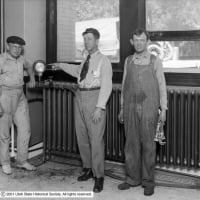Welcome! Here are the website rules, as well as some tips for using this forum.
Need to contact us? Visit https://heatinghelp.com/contact-us/.
Click here to Find a Contractor in your area.
If our community has helped you, please consider making a contribution to support this website. Thanks!
Need gravity system job advise...
Options

Timco
Member Posts: 3,040
Gravity. Has 3" main return under the slab, about 15' long, and that's where the major leak is.
Does not want to swap this mid winter, wants to do WH and the whole enchilada this spring, so this is a permanent temp fix.
I am thinking 1" copper to bypass the leak, tie in returns that currently hit that low 3" line into new 1" return, cap roof vents, xtank, tiny pump on the new return to barely pull water through. One main monoflow tee loop, and one small 2-pipe zone with 2-3 rads.
Does not want to swap this mid winter, wants to do WH and the whole enchilada this spring, so this is a permanent temp fix.
I am thinking 1" copper to bypass the leak, tie in returns that currently hit that low 3" line into new 1" return, cap roof vents, xtank, tiny pump on the new return to barely pull water through. One main monoflow tee loop, and one small 2-pipe zone with 2-3 rads.
Just a guy running some pipes.
0
Comments
-
BTUs
How many BTUs are you going to need to circulate with the new system? One inch might be light.0 -
From the hip?
200-250k. Another 2200 sq' bungalow with 400k under it!Just a guy running some pipes.0 -
Future
Gotta do the heat loss now. You're gonna need the info anyway, to size the new boiler. My 2000 sq/ft colonial, 1925, uninsulated has a heat loss of just over 100k.Unless they plan on leaving the windows open all winter, I doubt they are over 200k.0 -
monoflow?
MONOFLOW?0 -
Mono
Oops. Guess that's more diverter Tee?
I say 250 because off the kitchen is all (mostly) glass room then possible add on if that room is taken off and made larger with rooms above.
Since I need to get heat reliable and this is only 15' of pipe, I'd rather do a Heatloss when I've got more time and they commit.Just a guy running some pipes.0 -
Need
To have some idea of flow requirements through the system.Whether you do a heat loss, or use Steamheads method for circ sizing. http://www.heatinghelp.com/article/343/Circulators/238/Sizing-Circulators-for-Hot-Water-Heating-Systems
Shouldn't be any monoflow a.k.a diverter tees on a gravity system. No main loop either, just large supply and return pipes.0 -
Mono / diverter
In the pics you can see the fittings each rad takes off of. It's 1 pipe gravity with some special tee.Just a guy running some pipes.0 -
Wow
If the supply and return are off the same pipe in a gravity system, I have never seen that before. It defies the laws of thermal dynamics.0 -
1-pipe gravity
Third I've seen like this. One other is like a 6" pipe leaving boiler area and reduces to 4". 1-pipe with diverter tees gravity. That's why I want one tiny pump, to pump as slow as possible to make it fly.Just a guy running some pipes.0 -
How
or why that works..I have no clue. Also, what might upset the apple cart,also, no clue. It works, ya can't argue that, but ya gotta wonder if it was one plumbers confusion about the "New-fangled" monoflow tees.0 -
Forward flow stratification...
I have seen numerous of those gravity one pipe systems as well. They were originally released around the early 1900's in an effort to match the low cost of installation associated with 1 pipe steam. It scoops the hot water off of the top of the pipe,and returns the cooler water to the bottom of the pipe, The fluid is "layered" at that point. I have found that the flow needs to be real subtle, and not violent. The friction of the cool settling water drags the hotter less dense water up hill. For more information on that phenomena, Google a Tesla Turbine. There is a very interesting friction connection.
I think I have seen one system that was counterflow, but may have been a pipe settling issue more than anything. Generally speaking, they work amazingly well. I think the special fitting is called an OS fitting, named after its inventor, Oliver Schlemmer (SP?). EDIT, It is known as the Eureka fitting.
http://www.heatinghelp.com/files/articles/1204/366.pdf
I believe if you look in Dan's archives, you will find the fitting. Click on the attached link for patent information and a cutaway of the fitting.
Use a 30 or 40 degree delta T for your flow/load calculations and you should be just fine.
ME0 -
Learn
MANY things new , every day here
Thanks Mark0 -
Layered Flow
Like Mark said, keep the flow as near to gravity as possible. You might want to use a small Delta T circ set at least 35*.
You may also want to rethink down sizing the return line to 1". That's gonna cause turbulence that may or may not get absorbed in the larger piping. 3" cu. is expensive, but it's your safest choice to keep things as near original as possible.
When I you go with a new boiler, a large low loss header would be advised. Again, you want to minimize turbulence in the original piping.
It still amazes me: the genius of our hydronic forefathers. Look at this system. It's still cranking along after 100 years: no pumps, no zone valves, just natural gravity flow. Had they realized the corrosiveness of concrete and wrapped the return, it would have still been rolling along.Bob Boan
You can choose to do what you want, but you cannot choose the consequences.0 -
downsize
Agree on 1" being too small. Since Im pumping slow and have a nice long run maybe 2" black? It can reduce at a 90 since im going up and over now. Only one retun in that area and its off a added 2-pipe loop of 2-3 radsJust a guy running some pipes.0
Categories
- All Categories
- 87.3K THE MAIN WALL
- 3.2K A-C, Heat Pumps & Refrigeration
- 61 Biomass
- 429 Carbon Monoxide Awareness
- 120 Chimneys & Flues
- 2.1K Domestic Hot Water
- 5.8K Gas Heating
- 115 Geothermal
- 166 Indoor-Air Quality
- 3.7K Oil Heating
- 77 Pipe Deterioration
- 1K Plumbing
- 6.5K Radiant Heating
- 395 Solar
- 15.7K Strictly Steam
- 3.4K Thermostats and Controls
- 56 Water Quality
- 51 Industry Classes
- 50 Job Opportunities
- 18 Recall Announcements

